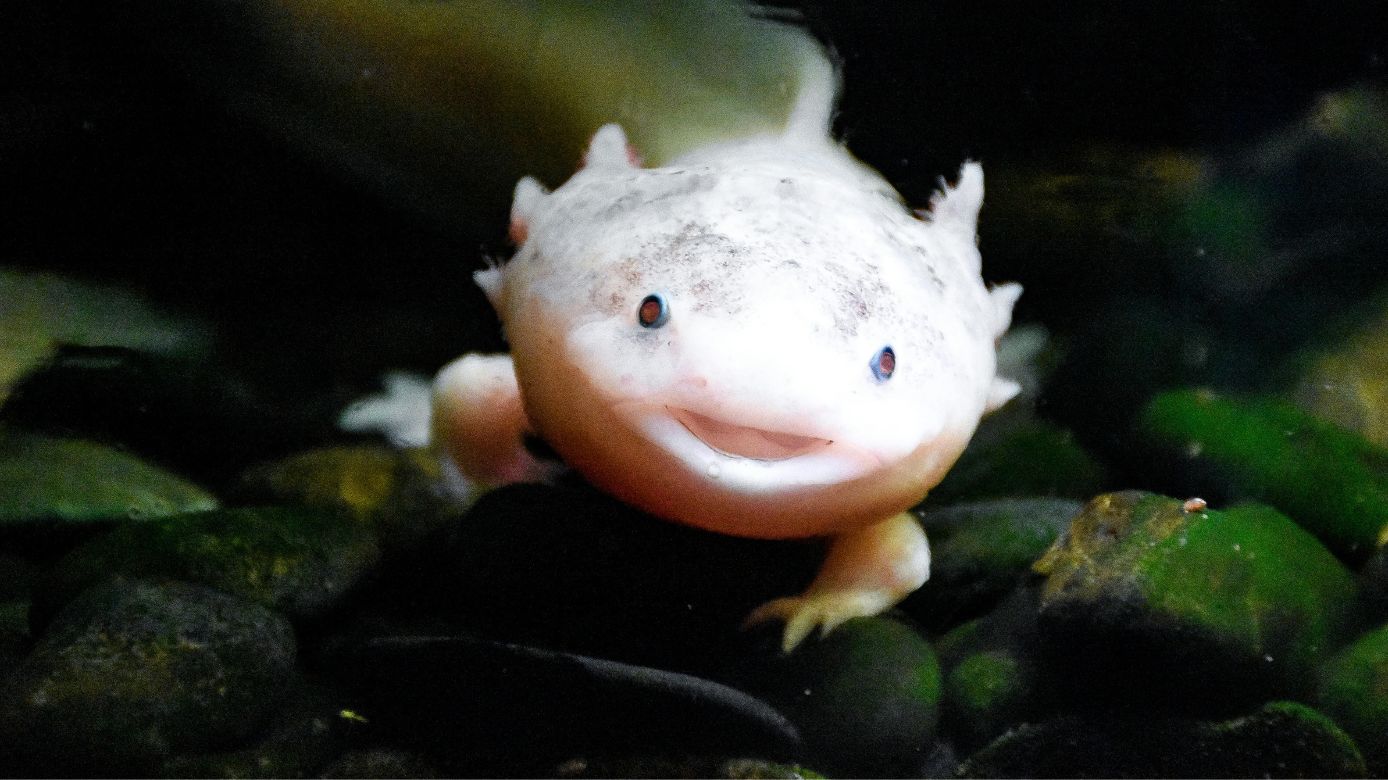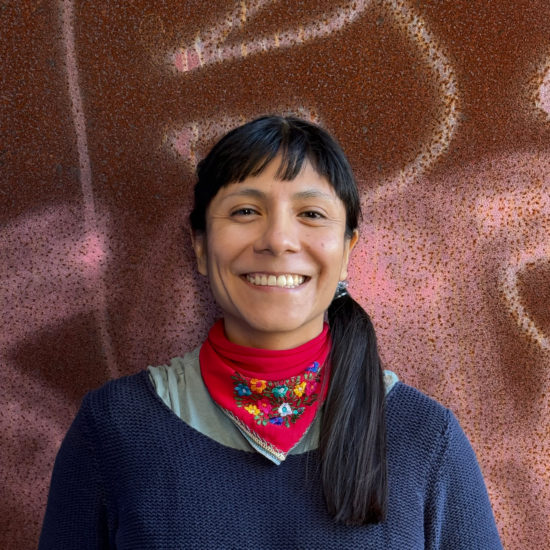
Navigating an environment marred by pollution, the axolotl swims in the dark and grimy waters of Xochimilco Lake, its limbs floating in the current and its long, extended mouth making it look like it is playing, even smiling.
Axolotls are “the aquatic youth of the fire animal, the salamander”.1 They are amphibious and enjoy a unique biological feature called neoteny which allows them to continue their life in a larval stage and not become land salamanders. Because of this, humans have variously cataloged axolotls as beings in “truncated development”,2 a “phyletic reversion”,3 or the “Peter Pan of salamanders”.4 But what is perhaps more interesting about axolotls is that they are even better equipped to repair themselves than their evolutionary “older cousins”, the salamanders. So, why become a salamander when it is possible to stay an axolotl?
The word axolotl comes from Nahuatl, which is the language of the Mexicas (the name the Aztecs took on after building Tenochtitlán), and it carries several meanings. It is constructed from the words atl, meaning water, and xolotl, which can be translated as toy, twin, or monster: “‘water toy’, ‘aquatic monster’, ‘water twin’ … but it is clear that it refers to the God Xolotl”.5 In the Mexica’s cosmovision, Xolotl – out of skepticism for the practice – refused the other gods’ demands to sacrifice himself and tried to escape his ordered death. This reflects axolotls’ capacity to avoid destruction. Through a curious genomic ability, these amphibians can regenerate their limbs, tissues, and cells. If one of their extremities is lost, they can grow it back in a couple of weeks. Due to this feature, it is not surprising that the Mexicas also believed that Xolotl was the one responsible for recreating humanity after an extinction.
In the sixteenth century, Spanish missionary Andrés de Olmos recounted the Mexica legend of the creation of women and men in this way:6 Xolotl was chosen by the other Gods to recreate humanity after it had been laid to ashes and dust. In order to do so, he would have to travel to the Mictlán (the Place of Death) to acquire a human bone. Xolotl asked Mictlán Tecuhtli (the Lord of Death) for permission to descend to his lair in search of the bone and at first the Lord of Death accepted. But once Xolotl entered, Mictlán Tecuhtli changed his mind and began to pursue him. In his attempt to escape Mictlán Tecuhtli’s rage, Xolotl stumbled and dropped the human bone, shattering it. However, Xolotl collected the pieces and escaped, successfully creating humanity once more. According to the legend, the different sized pieces explain why some humans are taller than others.
Creating with remains, recreating with the pieces of what was before. This mythical characterization echoes some challenges we face with reparations.
It is not only with remains, however, that axolotls create. Dr. Elly Tanaka, a biochemist expert on salamanders, leads one of the largest studies on axolotls’ regenerative processes. She states that for an axolotl to regrow a lost limb, “… the skin cells that cover the edge of the wound transform back to embryonic cells, the type that you would find in an axolotl’s developing limb.”7 No scar is left behind because these are not healed limbs, but new ones.
Axolotls’ rehabilitation is also defined by its precision. Dr. Tanaka explains: “When an axolotl’s hand is sliced off, it regenerates only the hand, but if the entire arm is lost, it regenerates the whole arm. What we are trying to understand is how an extremity knows just how much needs to be regenerated; in other words, how unnecessary duplications are avoided.”8 It’s as though, after a trauma, axolotls know and recreate exactly what is essential for their lives.
Creating from remains, recreating from scratch; in place of scars, new beginnings.
We might imagine that having the possibility of always producing stem cells – young cells, newborn cells – axolotls’ systems could lack a memory of the damage. However, it should be mentioned that in some cases axolotls are not able to regenerate their limbs completely. We could understand this incomplete new extremity as the axolotl version of a scar. I also wonder about how they experience even their “perfectly” regenerated tissues and members. Maybe they feel a scar instead of showing it.
But as a non-amphibious being, I can only speculate about how axolotls experience their own reparations.
I see an axolotl’s pin eyes and big smiling mouth; I like how its feathery gills move with the currents, like a penacho in the wind. Little “water monster”, little “water dog”. I see an axolotl come up for air. When its head breaks the surface, and it opens up its smile, I can almost hear its whisper: let’s create from what remains, recreate from scratch and face our scars. We have a lot at our disposal – and a(x)lot(l) to be repaired.
Diana María Rodríguez Vértiz
1. Roger Bartra, La jaula de la melancolía: Identidad y metamorfosis del mexicano (Grijalbo, 2003), 56. The translations from Bartra’s text are my own.
2. Bartra, La jaula, 143.
3. Bartra, La jaula, 143.
4. “Ajolote,” WWF, https://www.worldwildlife.org/descubre-wwf/historias/el-ajolote-el-peter-pan-de-las-salamandras.
5. Bartra, La jaula, 83–84.
6. I paraphrase the priest Andrés de Olmo’s version of the legend included in Gerónimo de Mendieta’s book Historia eclesiástica indiana from the sixteenth century. The account is based on paintings and testimonies of different caciques from Tezcuco, Tlaxcala, Huexotzinco, Cholula, Tepeaca, Tlalmanalco, and other first nations that lived near what is now Mexico City. Gerónimo De Mendieta, Historia eclesiástica indiana, published by Joaquín Díaz Icazbalceta (Antigua librería, 1870), https://www.cervantesvirtual.com/obra-visor/historia-eclesiastica-indiana–0/html/25fcbc58-feda-4cef-9d88-0cbbea9c279d_35.html#I_22_.
7. Elly Tanaka, “El ajolote en boca de todos,” interview by Juan Pablo Bertazza, Nexos, 24 August 2021, https://cultura.nexos.com.mx/el-ajolote-en-boca-de-todos/. I would like to thank Thomas Grizzle for translating this interview and editing this blog entry.
8. Tanaka, interview.
Diana Rodríguez Vértiz. “Axolotl to Repair”. The Reparation Blog, 15 April 2025. https://cure.uni-saarland.de/en/mediathek/blog/axolotl-to-repair/.
